Data professionals rely on myriad tools and technologies to extract knowledge from the volumes of data commonplace in today’s organizations. The best data science tools should respond to your organization’s unique needs, the scale and complexity of your data projects, and the expertise of your data science team. To help make sense of that market, we compared the top seven solutions data professionals use to make data-driven decisions and ranked them based on how well they performed across key categories.
Here are our top data science tool picks for 2024:
- Databricks: Best for Data Science, Documentation, and Learning
- Cloudera: Best for Scalability
- Snowflake: Best for Cloud Data Warehousing
- Alteryx: Best for ML and Workflows
- KNIME Analytics Platform: Best for Open-Source Usage
- Azure Synapse: Best for Azure Ecosystem Functionality
- Saturn Cloud: Best for Rapid Deployment
Featured Partners: Business Intelligence Software
Best Data Science Tool Comparison
Though data science has long since entered the business mainstream—and even more so with the rise of artificial intelligence and machine learning (AI/ML)—the discipline is mostly relegated to the enterprise. Most data science tools and solutions are priced accordingly, aside from a few open-source and lower cost alternatives. Here’s a look at how the top seven solutions scored on our rankings.
| Core Features | Enterprise Features | User Support | Key Differentiator | Pricing | |
|---|---|---|---|---|---|
| Databricks |
|
|
|
Powered by Apache Spark | Starts at $0.40 per Databricks Units (DBU) |
| Cloudera |
|
|
|
Integration with Cloudera Data Platform (CDP) | Starts at $0.04 per hour, per Cloudera Compute Unit (CCU) |
| Snowflake |
|
|
|
Separation of storage and compute | Based on storage compute, and cloud service costs |
| Alteryx |
|
|
|
Heavy focus on automation | Starts at $4,950 per user, per year |
| KNIME Analytics Platform |
|
|
|
Open-source platform with enterprise scale |
|
| Azure Synapse |
|
|
|
Integration with Azure ecosystem | Starts at $4,700 per 5,000 Synapse Commit Units (SCUs) |
| Saturn Cloud |
|
|
|
Pre-configured environments |
|
Table of Contents
Databricks Platform
Best for Data Science, Documentation, and Learning
Overall Rating: 4.5/5
- Core Features: 4.8/5
- Enterprise Features: 4.5/5
- Integrations: 4.4/5
- Cost: 4/5
- Ease of Use: 5/5
- Customer Support: 3.8/5
Databricks is a renowned data analytics and machine learning platform that simplifies and accelerates data processing, analysis, and model development. Founded by the creators of Apache Spark, it offers a collaborative environment for data professionals to work together efficiently. With its powerful data processing capabilities, interactive workspace, and automation features, Databricks has become an indispensable tool for enterprises looking to harness the full potential of their data, enabling them to make data-driven decisions and gain a competitive edge in today’s data-centric landscape.
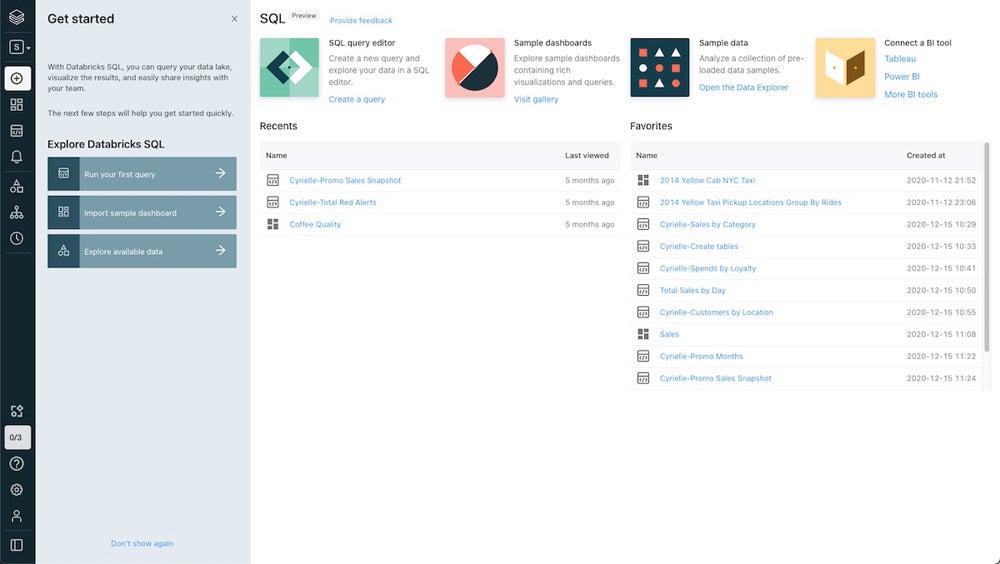
Product Design
Databricks features an intuitive and unified workspace built around Apache Spark, which offers a robust open-source platform for processing enterprise-grade data. Its data intelligence platform integrates with cloud storage and cloud account security, deploying cloud infrastructure on your behalf. Additionally, the platform uses generative AI combined with a data lakehouse to help you analyze the unique semantics of your data and automatically optimize your infrastructure to respond to business needs.
Product Development
Databricks is constantly evolving, with a focus on continuous improvements and new features. Recent innovations include the availability of compute cloning in any installed libraries, route optimization for serving endpoints, and the release of the public preview features in Databricks for the Delta Live Tables notebook. Customers and partners also now have the flexibility to design secure cloud solutions compliant with the FedRAMP High baseline via Databricks on AWS GovCloud.
Why We Picked Databricks
We choose Databricks as our top choice for data science, documentation, and learning as it combines a user-friendly interface and a robust suite of data analytics features in a cloud-based solution. Data scientists benefit from the platform’s scalability with its extensive libraries and collaborative workspace through Databricks Notebook, simplifying the process of building data and AI projects. Databricks Notebook also works natively with the Lakehouse platform, empowering data practitioners to start quickly and easily share results.
Pros and Cons
| Pros | Cons |
|---|---|
| Powerful data processing, analytics, and ML in one platform | Relatively expensive, particularly for smaller businesses or organizations with limited budgets |
| Streamlined collaboration and a unified data toolset for managing multiple tools and platforms | Full range of features presents a significant learning curve |
| A wealth of learning materials and documentation for boosting data science productivity and accelerating the development of data-driven solutions | Significant vendor lock-in makes transitioning away from Databricks challenging |
Pricing
- Starts at $0.40 per Databricks Units (DBU)
- 14-day free trial and free Community Edition available
Features
- Unified data analytics lifecycle management in a single platform
- Distributed data processing through Apache Spark lets organizations process massive datasets in real time
- Interactive workspace for writing and executing code in various programming languages
- Automation and integrated AI features for building out data pipelines and harnessing advanced ML capabilities
Cloudera Data Science Platform
Best for Scalability
Overall Rating: 4.3/5
- Core Features: 4.9/5
- Enterprise Features: 5/5
- Integrations: 4.4/5
- Cost: 3.6/5
- Ease of Use: 3.9/5
- Customer Support: 2.3/5
Cloudera is a long-standing leader in enterprise data management and the analytics platform space. Known for its commitment to open-source—and its pioneering role in the Hadoop ecosystem—Cloudera offers a data platform for efficiently storing, processing, and analyzing vast amounts of enterprise data. For a number of years now, Cloudera’s data platform has been a go-to for enterprises looking for a secure, scalable solution to unlock their data assets. The company is now positioning its solution as a hybrid, multi-cloud data platform for building AI and predictive analytics.

Product Design
Cloudera is designed for scalability and enterprise-grade analytics, offering a flexible and highly customizable platform. For instance, its modular architecture design allows you to choose the data management tools you need for your business, from data warehousing to machine learning. Its data platform also seamlessly integrates open-source solutions, including Apache Spark and Hadoop, providing a unified environment for data scientists.
Product Development
Cloudera continuously innovates to stay ahead of the curve, and its recent advancements include unveiling the next phase of its open data lakehouse focused on maximizing customer data for enterprise AI. Cloudera announced that its latest round of enhancements will allow the platform to become the only provider to offer an open data lakehouse with Apache Iceberg for both public and private clouds. This development will let customers “unleash the enterprise AI potential” of their data.
Why We Picked Cloudera
Cloudera stands out as a data science tool, offering data practitioners an open-source foundation that provides the opportunity for flexibility and scalability. As a hybrid data platform, Cloudera can deliver efficient data management and analytics in any cloud. You can leverage the advantages of private and public clouds with Cloudera’s unified system, and its modular architecture allows you to scale specific components within the platform to match your needs. Additionally, Cloudera lets you efficiently manage such resources as storage and compute power so they can perform optimally at any scale.
Pros and Cons
| Pros | Cons |
|---|---|
| Easily scales to large and complex data workloads due to its distributed computing capabilities | Setup and configuration can be complex, requiring skilled administrators and in-depth knowledge of big data technologies |
| Allows for myriad customization options, enabling organizations to build highly specialized data solutions | Licensing and infrastructure costs can be high and unsuitable for smaller organizations or startups |
| Advanced security and compliance features for ensuring data integrity and adherence to regulatory requirements | Steep learning curve, particularly for new data science and big data users |
Pricing
- Starts at $0.04 per hour, per Cloudera Compute Unit (CCU)
- 60-day free trial available
Features
- Comprehensive suite of tools for data management, including data ingestion, storage, and processing
- Scalable and distributed computing built on the foundations of Hadoop and Apache Spark
- Advanced security and governance via robust authentication, authorization, and auditing features
- Rich ecosystem of compatible tools and integrations allows organizations to adapt to their specific data processing and analytics needs
Snowflake
Best for Cloud Data Warehousing
Overall Rating: 4.2/5
- Core Features: 4.7/5
- Enterprise Features: 4.7/5
- Integrations: 4.1/5
- Cost: 3/5
- Ease of Use: 5/5
- Customer Support: 2.7/5
Snowflake developed a modern and highly regarded cloud-based data warehousing platform that has revolutionized the way organizations manage and analyze their data. Known for its elasticity and scalability, Snowflake’s data warehouse features a unique multi-cluster, shared data architecture that separates storage from compute functions, allowing users to independently and efficiently scale their data storage and processing needs.
Snowflake integrates with popular business intelligence (BI) tools and provides full SQL compatibility, making it ideal for enterprises looking to accelerate their data science endeavors while enjoying the benefits of a fully managed, cost-effective, and secure data warehousing solution in the cloud.
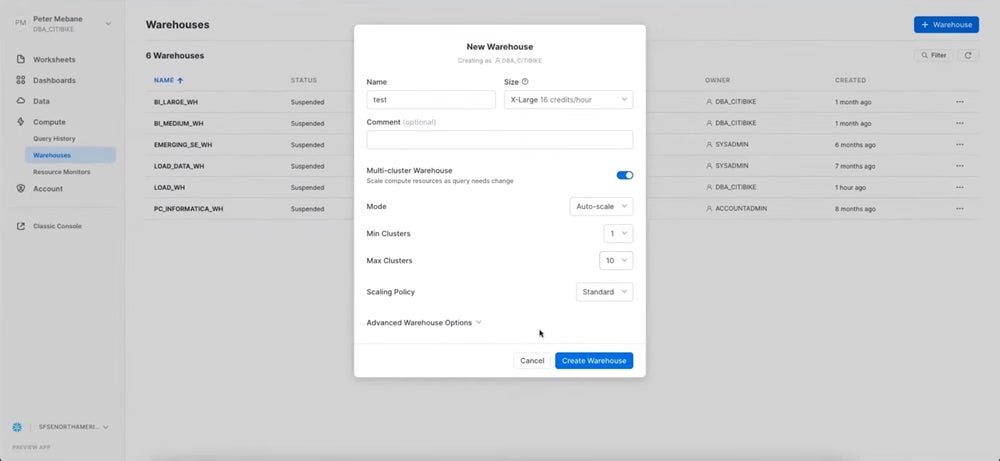
Product Design
Snowflake’s intuitive and easy-to-use web-based interface lets you easily create and manage virtual warehouses, databases, and database objects. You can also load limited amounts of data and convert it to tables, implement ad hoc queries, view previous queries, and more. Another key feature of Snowflake’s platform is its unique design, which separates data storage from compute storage to offer more flexibility and scalability for resource allocation. The platform’s documentation, tutorials, and other onboarding resources provide helpful knowledge about Snowflake’s UI.
Product Development
Snowflake’s latest innovations include the release of Snowpark Model Registry, Streamlit, in Snowflake for Azure, and new enhancements around security features in Snowflake Horizon. Snowpark Model Registry is an integrated solution for using models and their metadata natively on the platform, while Streamlit is a widely used open-source library that’s now turned into a full-managed service within Snowflake. Additionally, Snowflake Horizon improved its network security and network isolation to S3 internal stages and rolled out new authentication enhancements.
Why We Picked Snowflake
We chose Snowflake because of the advantages it offers over more traditional cloud data warehouses. Snowflake stores all data in a centralized repository that can be easily accessed through a virtual warehouse, providing greater flexibility and scalability. This platform also has built-in high availability data protection and data retention, protecting organizations and businesses against malicious attacks, human errors, and more.
Snowflake offers a clean and intuitive user interface that lets data scientists simplify processes for data management, analysis, and visualization. It also offers a cost-effective option for users with its pay-as-you-go pricing model, which eliminates upfront infrastructure costs.
Pros and Cons
| Pros | Cons |
|---|---|
| Cloud-based architecture for unprecedented scalability without extensive infrastructure management | Usage-based pricing model can become costly for organizations with substantial data volumes and intensive workloads |
| Strong data sharing and collaboration features make it easier to safely share data for cross-functional/organizational insights and decision-making | High learning curve for data professionals new to cloud data warehousing concepts, SQL, and related technologies |
| Simplifies data management by automating many administrative tasks like maintenance, upgrades, and security | Data migration process can be challenging |
Pricing
- Based on storage (on-demand, $23 per terabyte per month), compute, cloud service costs
- 30-day free trial available
Features
- Enterprise data warehousing offers cloud flexibility and scalability
- Robust data-sharing capabilities for secure internal and external collaboration
- Zero-copy cloning lets users create instant, cost-effective copies of data for development, testing, or analytical purposes
- Built-in data transformations and analysis functions
Alteryx
Best for ML and Workflows
Overall Rating: 4.1/5
- Core Features: 4.2/5
- Enterprise Features: 4.7/5
- Integrations: 4.7/5
- Cost: 3/5
- Ease of Use: 4.7/5
- Customer Support: 3.3/5
Alteryx helps organizations easily blend, cleanse, analyze, and visualize their data with its user-friendly, no-code drag-and-drop interface. This makes the platform accessible to both data analysts and business operations professionals, letting users across the enterprise transform raw data into actionable insights with ease. Beyond data preparation, Alteryx offers advanced predictive and spatial analytics capabilities that let you create complex workflows and models and automate repetitive data-related tasks.

Product Design
Alteryx Designers lets you prepare, blend, and analyze data using the same user interface. This application features a drag-and-drop function that makes it easier to orchestrate with data, including using machine learning and building workflows. Alteryx Designer lets you create a user-friendly interface and configure workflows by connecting tools that perform various data functions. You can add, remove, and connect multiple tools at once, as well as customize workflows from basic templates in the platform.
Product Development
Alteryx recently announced that Alteryx Analytics Cloud platform is now known as the Alteryx AI Platform for Enterprise Analytics. This product development maintains the core value of keeping analytics for all, but new solutions are now being accelerated and enhanced by AI. Alteryx’s AI solution is enterprise-grade, which means it is transparent and auditable. The new platform is available on-premise, hybrid, and in the cloud, allowing you to automate and drive business growth wherever you are.
Why We Picked Alteryx
We chose Alteryx as our top option for creating workflows and ML models for its visual and user-friendly interface and pre-built tools, helping you simplify model building and streamline workflow management. Alteryx no-code cloud solution democratizes ML, and its automated ML feature scales data science processes. You can also build repeatable, automated workflows that include data prep, model training, evaluation, and more. Additionally, teams and departments can easily share and reuse workflows, facilitating knowledge sharing within the data science community.
Pros and Cons
| Pros | Cons |
|---|---|
| Intuitive dashboards and visual workflow management features accelerate data-related tasks and foster collaboration | High price tag makes it out-of-reach for individual users and organizations with budget constraints |
| Strong data blending and workflow automations features help to reduce manual data-related work | Limited open-source ecosystem limits flexibility and integration options |
| Advanced analytics and predictive modeling capabilities | Running complex workflows in Alteryx may require significant computing resources |
Pricing
- Alteryx Designer Cloud starts at $4,950 per user, per year
- Minimum three user licenses
- 30-day free trial available
Features
- Advanced tools for combining, cleaning, and preparing data from various sources without complex coding
- Automated workflows for data analysis, processing, and reporting
- Advanced analytics and predictive modeling capabilities, including data mining, statistical analysis, and ML
- User-friendly, visual interface designed for both technical and non-technical users
KNIME Analytics Platform
Best for Open-Source Usage
Overall Rating: 4.1/5
- Core Features: 3.8/5
- Enterprise Features: 4.4/5
- Integrations: 5/5
- Cost: 4/5
- Ease of Use: 5/5
- Customer Support: 2.1/5
KNIME Analytics is a leading open-source data analytics and ML platform renowned for its user-friendly, visual workflow design. With a diverse and extensive suite of tools and integrations, KNIME empowers data scientists and analysts to preprocess, analyze, and model data, facilitating the creation of robust data-driven solutions. The platform’s modular and flexible nature allows you to customize workflows for your specific needs, and the platform supports unstructured and structured data from a wide range of data sources.
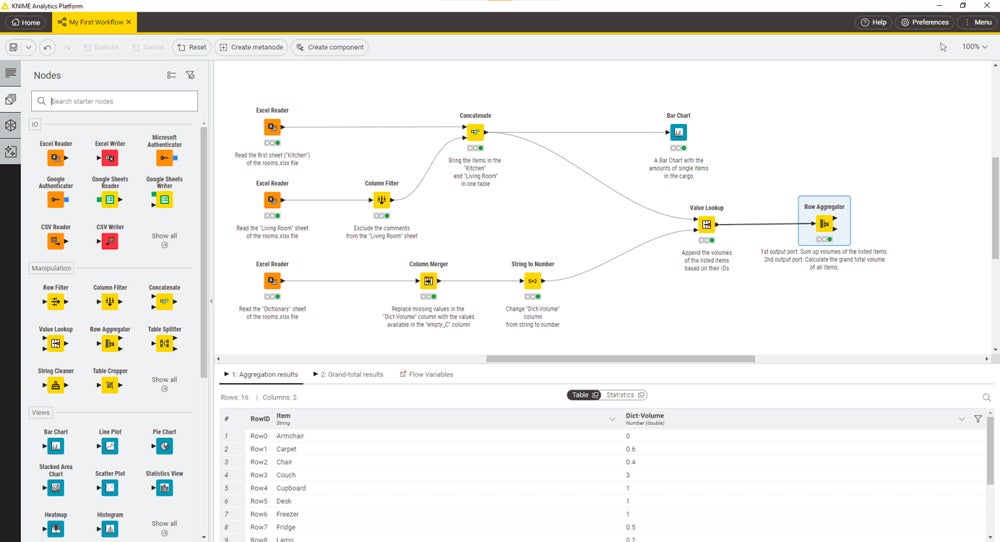
Product Design
KNIME Analytics currently features a preview of its modern UI, which is still in development, letting users create new workflows and open or modify existing ones. However, you can switch back to the previous UI by simply using the button at the top right corner of the dashboard.
Product Development
KNIME Analytics has already enhanced its recently introduced KNIME AI assistant, informally known as K-AI. The K-AI is a chatbot meant to answer your KNIME-related questions, either with text or by improving the currently opened workflow. This AI extension is a classic extension and gives you the ability to connect to large language models (LLMs), chat models, embedding models, and more. You can also build and combine multiple vector stores and LLMs.
Why We Picked KNIME Analytics
KNIME Analytics stands out as an intuitive open-source platform designed for building and executing workflows for data science processes. KNIME offers users who prefer an open-source platform several advantages, such as being free to use, easily customizable, and transparent. It also has a vibrant and active open-source community that continuously collaborates to innovate and contribute to improving the platform. KNIME’s user community offers support, tutorials, and easily accessible and shareable resources, making it easier to learn about the platform, innovate, and troubleshoot.
Pros and Cons
| Pros | Cons |
|---|---|
| Open-source, cost-effective choice for powerful data analytics | Mastering advanced features takes time, especially for new data analytics professionals |
| Visual workflow design enables complex data analysis without extensive coding skills | Performance may not be as robust as some commercial tools |
| Various data sources and external tool integrations address different data analysis use cases | Limited support and documentation compared to other data science tools |
Pricing
- KNIME Community Hub runs from free to $99 per month for small teams
- KNIME Business Hub starts at $39,900 per year
- Free open-source version available
Features
- Open-source platform includes a comprehensive set of tools for data analytics
- Visual workflow designer offers a user-friendly, drag-and-drop interface for designing data analysis workflows
- Extensive integrations make it flexible and versatile for working with diverse data types and analytics processes
Azure Synapse Analytics
Best for Azure Ecosystem Functionality
Overall Rating: 4.1/5
- Core Features: 5/5
- Enterprise Features: 4.8/5
- Integrations: 4/5
- Cost: 4/5
- Ease of Use: 2.6/5
- Customer Support: 2.8/5
Azure Synapse Analytics (formerly SQL Data Warehouse) is a comprehensive, powerful analytics service available via Microsoft Azure. The service integrates big data and data warehousing in a unified platform for data storage, processing, and analysis. With its robust data integration capabilities, analytics, and AI features, Azure Synapse Analytics gives organizations a full range of options for efficiently exploring, visualizing, and sharing data-derived insights in a secure and compliant manner.
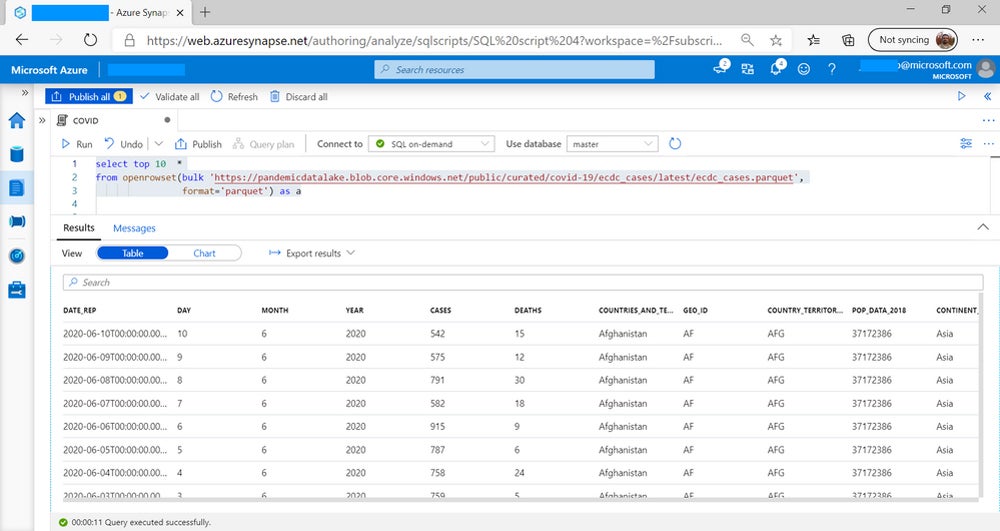
Product Design
Azure Synapse is an enterprise analytics solution that provides a unified workspace, bringing together the best SQL technologies used in data warehousing, big data processing, data integration, and more. This platform has a deep integration with other Azure services—including Power BI, CosmosDB, and AzureML—that fosters a collaborative environment for data management, analysis, and visualization. It offers both serverless and dedicated resource models, offering you the flexibility to choose what works best for your needs and budget.
Product Development
Last year, Microsoft announced the general availability of Microsoft Fabric, an end-to-end SaaS solution for data and analytics built on top of OneLake and Microsoft tools. While Fabric represents a significant upgrade to Microsoft’s analytical engine, the company emphasized that it has no current plans to retire Azure Synapse Analytics. You can continue to deploy, operate, and expand the PaaS capabilities of Azure Synapse Analytics. However, Azure Synapse runtime for Apache Spark 3.1 was retired earlier this year in compliance with the Synapse runtime for Apache Spark lifecycle policy.
Why We Picked Azure Synapse Analytics
We chose Azure Synapse Analytics as the best data science solution for the Azure system functionality as it offers seamless integration with other Azure products. As a native Azure service, Synapse Analytics creates a unified data ecosystem for data management, analytics, and other data processes. This platform is also scalable and can accommodate massive and growing data volumes for organizations and businesses of all sizes. Additionally, as Synapse Analytics provides a unified workspace, you can simplify workflows and data management using multiple tools.
Pros and Cons
| Pros | Cons |
|---|---|
| Single platform for data warehousing and big data analytics, streamlining data workflows and reducing the need for multiple tools | Implementation and configuration can be complex, requiring specialized skills and expertise |
| High scalability lets organizations adjust analytic capabilities and workloads by tweaking computing and storage resources | High scalability and feature-rich environment come at high operational costs |
| Integrations with Azure services provide a comprehensive ecosystem for building powerful data solutions | Poses a significant learning curve for new Azure/cloud users |
Pricing
- Starts at $4,700 per 5,000 Synapse Commit Units (SCUs)
- Free trial available
Features
- Analysis of both structured and unstructured data in a single environment
- Scalable computing and storage resources for handling massive datasets and complex analytics workloads
- Seamless integrations with various Azure services, including data storage, ML, and data pipelines
- Versatile tool for building end-to-end data workflows
Saturn Cloud
Best for Rapid Deployment
Overall Rating: 3.8/5
- Core Features: 4.2/5
- Enterprise Features: 3.4/5
- Integrations: 4.2/5
- Cost: 4.4/5
- Ease of Use: 3.6/5
- Customer Support: 2.5/5
Saturn Cloud is a cloud-based data science platform that provides a powerful and accessible environment for data scientists and analysts to develop and deploy data-driven solutions. The solution is primarily a suite of tools and resources for data processing, ML, and model deployment. With an emphasis on scalability and reproducibility, Saturn Cloud supports both small-scale experiments and large-scale data projects.
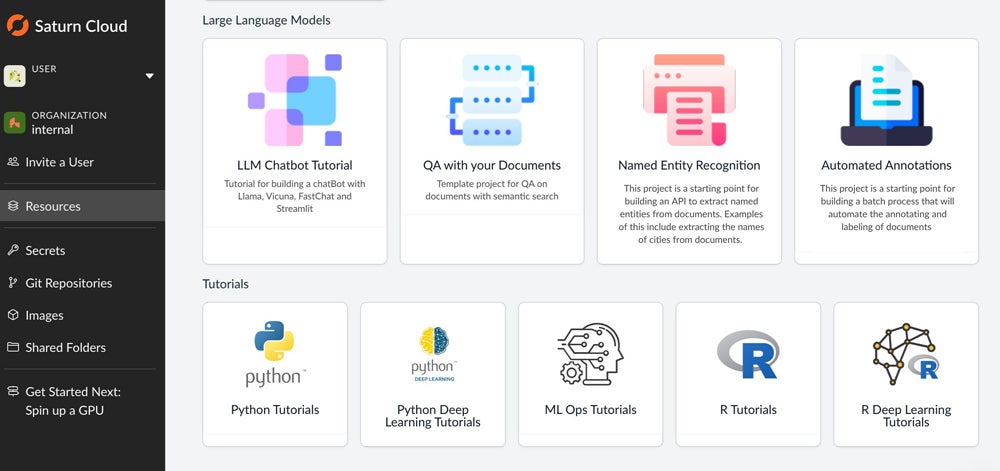
Product Design
Saturn Cloud is an all-in-one solution for data science and ML deployment, helping you simplify workflows, quickly access preferred tools, and scale efficiently. Deployments in Saturn Cloud are custom-defined apps that you can run on the platform and use as an API, a dashboard, or another running application. You can easily create deployments in Saturn Cloud through its clean and straightforward interface.
Product Development
Saturn Cloud has been continuously updated and enhanced and is now a complete end-to-end solution for fine-tuning and serving LLMs. You can access templates for fine-tuning LLMs and deploying LLM models serving endpoints. The platform’s security and reliability have also been upgraded to EKS 1.26, and there’s added resiliency to Saturn Cloud’s UI, enabling you to automatically restart the system in case it runs into issues.
Why We Picked Saturn Cloud
Saturn Cloud stands out as a top option for data science tools designed for rapid deployment. This platform features pre-built and ready-to-use environments, which eliminates the need for manual setup and reduces a significant amount of time. You can leverage its built-in tools to simplify the process of model deployment, reducing the complexity of transitioning models. Saturn Cloud is also scalable, which enables the platform to handle increased processing demands once the model deployment process has started.
Pros and Cons
| Pros | Cons |
|---|---|
| Managed cloud environment for data science and analytics removes infrastructure management concerns | Metered cloud services can quickly add up |
| Scalability for processing and analyzing large datasets harnesses cloud resources to handle resource-intensive tasks | Requires an internet connection; subsequently, users may experience limitations or disruptions in their work if they encounter connectivity issues or outages |
| Collaboration via version control and shared project environments enhances teamwork and ensures reproducibility in data science workflows | Users report slow loading times for images and other resources |
Pricing
- $5 credit purchase to start
- Pay by the hour billed in $10 increments
- Free version available
Features
- Cloud-based, managed data science platform—no infrastructure management required
- Scalable data analysis for processing and analyzing large datasets with cloud resources
- Strong collaboration and version control features
- Integrates with popular data science tools and libraries like Jupyter, Python, and Dask
4 Key Features of Data Science Tools
A competent data science tool should provide features for extracting insights from data in the shortest amount of time possible. These include data import and manipulation capabilities—for example, allowing users to easily ingest and preprocess datasets—as well as visualization tools for exploring and communicating findings and discoveries, advanced analytics algorithms, and integrated ML capabilities for developing predictive and descriptive models.
Data Preparation
Data preparation refers to the process of gathering, cleaning, organizing, and transforming raw data into a usable format for further analysis and processing. Data prep is essential in data science as it ensures that the data is of high quality and suitable for analysis, which results in more accurate and reliable results.
Data Integration
Data integration is the process of bringing together data from multiple sources into a unified dataset for analytical and operational purposes. This process allows for an accurate and holistic view of data, enabling businesses and organizations to access more comprehensive analyses and insights.
Data Visualization
Data visualization is the graphical representation of data to communicate information clearly and effectively. This tool helps businesses understand complex patterns and trends in data and also serves as an essential tool for storytelling, which might be difficult to grasp from raw data.
Machine Learning
Machine learning (ML) is a subset of artificial intelligence (AI) that focuses on using data and algorithms to identify patterns and make predictions. Data scientists can leverage ML to automate tasks, generate insights, train data models, and more. It can also support applications for various data science projects, including fraud detection, image recognition, and sentiment analysis.
How We Evaluated Data Science Tools
In comparing and contrasting these leading data science tools, we scored each solution against six criteria for businesses and organizations needing a comprehensive data science solution. Then, we identified weighted subcriteria for each category and assigned a total score out of five. Finally, we summed up the final scores to determine the winners for each category and their specific use cases.
Evaluation Criteria
We put the most emphasis on core features and enterprise features, as top software options should offer standard and advanced capabilities for data science processes. We then evaluated each option’s integration capabilities, cost, ease of use, and customer support.
Core Features | 30 percent
Data at-rest and in transit requires proper and specific handling and storage; a data science tool should therefore provide comprehensive data management features to meet these requirements. With the prevalence of predictive analytics, data professionals will likely require data pipeline management and workflow creation tools to support their organizations’ ML data infrastructures.
Criteria Winner: Azure Synapse Analytics
Enterprise Features | 20 percent
An enterprise data science tool requirement gaining prominence as of late is support for hybrid implementations—that is, data infrastructure/architectures that allow for local data storage—for example, a corporate data center—coupled with cloud-based compute and scaling services.
Criteria Winner: Cloudera Data Science
Integrations | 15 percent
Data science tooling integration features should include plentiful developer resources and a fully-realized REST API, as well as libraries for common data transformations and algorithms, and other in-application, data-specific tools and utilities.
Criteria Winner: KNIME Analytics Platform
Cost | 15 percent
Typically, data science tooling vendors will offer a free trial but limited upgrades/tiered pricing, opting for a metered pricing model instead. Because today’s data volumes and enterprise requirements necessitate cloud-enabled scalability and processing power, data science tooling vendors are increasingly moving to pricing models that align with the cloud.
Criteria Winner: Saturn Cloud
Ease of Use | 10 percent
Data science tools should be accessible and easy to use to demonstrate data analysis and fisher collaboration. The best data science tools should offer intuitive interfaces, user-friendly features that allow a broader range of people to utilize data, and a vibrant user community.
Criteria Winner: Databricks, Snowflake, KNIME Analytics Platform
Customer Support | 10 percent
Data science tooling vendors should offer multiple channels for support, including live chat, phone, email, and other forms of self-service support. Premium support is also a critical requirement for data science tools, as the main buyers in this category are usually enterprises with critical/urgent data needs.
Criteria Winner: Databricks
Frequently Asked Questions (FAQs)
What Are Data Science Tools?
Data science tools are software applications and platforms that enable data professionals to collect, process, analyze, and visualize data in order to derive meaningful insights and make informed decisions.
Why Are Data Science Tools Critical for Enterprise Strategy?
Data science tools empower organizations to harness the full potential of their data, enabling evidence-based decision-making and innovation. These solutions provide the means to extract insights from vast datasets, optimize operations, identify trends, and discover new opportunities.
What Features Should be a Priority When Evaluating Data Science Tools?
Key evaluation priorities should include usability and scalability for accommodating varying skill levels and data project sizes. Additionally, you should also evaluate features for data integration, collaboration, ML model deployment, and compliance.
Is Data Security a Concern When Using Data Science Tools?
In today’s cyberthreat landscape, controls for ensuring the protection of sensitive information and compliance with data privacy regulations are an operational imperative. A competent data science tool should provide robust security features, strong data encryption, access control, and auditing capabilities to mitigate potential risks.
Should I Select an On-Premises or Cloud-Based Data Science Solution?
This depends on your organization’s specific needs—cloud-based solutions offer scalability, accessibility, and reduced infrastructure management, while on-premises solutions may be preferred for greater control and compliance, particularly in cases where data governance or regulatory requirements are a primary concern. Your decision should align with your data infrastructure, budget, and long-term strategic goals.
Bottom Line: Enterprise Data Science Tools
Data professionals have never had more tool options at their disposal for harnessing the power of data. These top seven data science tools represent the current leaders in this space—whether you’re an aspiring data scientist, seasoned data analyst, or business professional/casual data wrangler, one or more of these offerings are likely to meet your organization’s data requirements and objectives.
Read Data Science Best Practices to learn how to implement the tools in this buyer’s guide most effectively.





